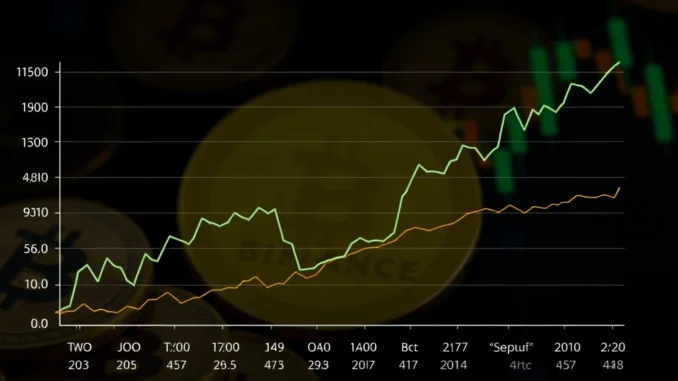
Ever wondered what the smart money is doing in the Bitcoin market? One of the most insightful metrics to gauge market sentiment is the long-short ratio for BTC perpetual futures. It’s like peeking under the hood of the crypto market to see whether traders are betting on Bitcoin going up (long positions) or down (short positions). Today, we’re diving deep into the latest 24-hour long-short ratio data across major cryptocurrency exchanges to give you a snapshot of the current market mood. Are traders leaning bullish or bearish on Bitcoin trading right now? Let’s find out!
Decoding the 24-Hour Bitcoin Long-Short Ratio: A Quick Snapshot
In the past 24 hours, the overall long-short ratio for BTC perpetual futures across all tracked cryptocurrency exchanges paints a slightly bearish picture:
- Overall Market Sentiment: Slightly Bearish
- Total Exchanges (Aggregated): Long positions at 49.37% vs. Short positions at 50.63%
This marginal lean towards short positions suggests that, collectively, traders are slightly more inclined to bet against Bitcoin in the immediate short term. However, let’s break this down further by examining the top three exchanges to see if this trend holds true across the board.
Deep Dive into Top Cryptocurrency Exchanges: Binance, OKX, and Bybit
To get a more granular view of the Bitcoin trading landscape, we’ve analyzed the long-short ratios on three of the leading cryptocurrency exchanges: Binance, OKX, and Bybit. These exchanges represent a significant portion of the BTC futures market, making their data highly relevant for understanding overall market sentiment.
Binance: The Market Leader’s Perspective
Binance, often considered the bellwether of the crypto market due to its immense trading volume, shows a similar bearish leaning in its BTC perpetual futures contracts:
- Binance Long-Short Ratio: Long positions at 48.49% vs. Short positions at 51.51%
The data from Binance reinforces the slight bearish sentiment observed in the overall market. With short positions slightly outweighing long positions, it indicates that even on the largest exchange, a cautious or slightly negative outlook prevails among futures traders.
OKX: A Closer Look at Trader Positioning
Moving on to OKX, another major player in the cryptocurrency exchanges arena, we see a nearly identical pattern to Binance:
- OKX Long-Short Ratio: Long positions at 49.13% vs. Short positions at 50.87%
OKX’s long-short ratio closely mirrors Binance’s, further solidifying the trend of a slightly bearish market sentiment. This consistency across two major exchanges strengthens the signal and suggests a broader market perception rather than exchange-specific anomalies.
Bybit: Is There a Divergence?
Finally, let’s examine Bybit, known for its derivatives trading and popularity among retail traders. Does Bybit’s data align with Binance and OKX, or is there a different story unfolding?
- Bybit Long-Short Ratio: Long positions at 49.84% vs. Short positions at 50.16%
Interestingly, Bybit’s long-short ratio is the closest to equilibrium among the three exchanges. While still technically leaning slightly towards short positions, the difference is minimal. This could suggest a less pronounced bearish sentiment on Bybit compared to Binance and OKX, or perhaps a more balanced view among its user base.
Why Does the Long-Short Ratio Matter for Bitcoin Trading?
Understanding the long-short ratio is crucial for anyone involved in Bitcoin trading and interested in gauging market sentiment. Here’s why this metric is so valuable:
- Sentiment Indicator: The long-short ratio provides a real-time snapshot of trader positioning. A higher long ratio might suggest bullishness, while a higher short ratio can indicate bearishness.
- Potential Trend Reversals: Extreme long-short ratios (either heavily long or heavily short) can sometimes signal potential trend reversals. For example, an overwhelmingly long market might be vulnerable to a long squeeze, while an excessively short market could be ripe for a short squeeze.
- Confirmation or Divergence: Comparing the long-short ratio with price action can offer confirmation or divergence signals. If price is rising but the long ratio is decreasing, it might indicate underlying weakness in the bullish trend.
- Risk Management: Monitoring the long-short ratio can help traders manage risk. Knowing the prevailing sentiment can inform position sizing and stop-loss placement strategies.
Interpreting the Current Bitcoin Market Sentiment
Based on the 24-hour long-short ratios, the current market sentiment for BTC perpetual futures appears to be cautiously bearish. While the difference between long and short positions is not dramatic, the consistent leaning towards shorts across major exchanges suggests a prevailing sense of caution or slight negativity among futures traders.
Key Takeaways:
- Slight Bearish Bias: Overall, short positions marginally outweigh long positions.
- Consistency Across Exchanges: Binance and OKX show similar bearish ratios, strengthening the signal.
- Bybit’s Balanced View: Bybit’s ratio is closer to neutral, potentially indicating a less pronounced bearish sentiment on that platform.
- Monitor for Changes: Market sentiment is dynamic. Keep an eye on these ratios as they evolve, as significant shifts can precede price movements.
Actionable Insights for Bitcoin Traders
So, what does this mean for you as a Bitcoin trader? Here are some actionable insights based on the current long-short ratio data:
- Exercise Caution: The slight bearish sentiment suggests a need for caution in your Bitcoin trading strategies. Avoid over-leveraging long positions in the short term.
- Consider Short-Term Shorts (With Caution): If you are an experienced trader, you might consider carefully entering short positions, but always with strict risk management in place. Remember, market sentiment can shift quickly.
- Watch for Sentiment Shifts: Continuously monitor the long-short ratios. A sudden shift towards long positions could signal a potential bullish reversal.
- Combine with Other Indicators: Don’t rely solely on the long-short ratio. Use it in conjunction with other technical indicators, on-chain metrics, and fundamental analysis for a more comprehensive view of the Bitcoin trading landscape.
Conclusion: Navigating Bitcoin’s Volatile Waters
The 24-hour long-short ratio for BTC perpetual futures offers a valuable glimpse into the current market sentiment. While the data currently suggests a slightly bearish leaning, it’s crucial to remember that the cryptocurrency market is incredibly dynamic and can change direction rapidly. By understanding and monitoring metrics like the long-short ratio, you can gain a more informed perspective on Bitcoin trading and navigate the volatile crypto waters with greater confidence. Keep an eye on these ratios, stay informed, and trade wisely!



